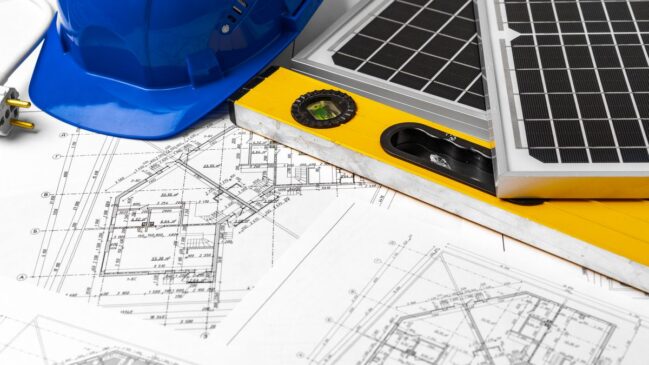
Photo by Kindel Media on <a href="https://www.pexels.com/photo/industry-house-roof-technology-9875449/" rel="nofollow">Pexels.com</a>
This is a case study of ricky from channel tuba davinci
In june of 2011 I got solar panels installed on my house not just to save money, but as a science experiment.
Now ten years later I’d like to share everything I’ve learned through this journey with all of you.
I spent ten thousand dollars on my system before incentives, and in the past 10 years so much of my life has changed. I’m on my second refrigerator, my third car, I got married and I have two kids. yet these 10 year old solar panels have been a beacon of consistency.
But it’s not entirely sunshine and rainbows.
So in this time, What have I learned?
What do I wish I knew before I made this decision?
This case study will discuss,
system hardware, type of panels, inverters that sort of thing, also the data and numbers, and the prices and how it’s changed in 10 years,
the total cost of maintaining a system over 10 years… and much much more.
So first let’s talk about the system specifics and dig a little deeper into what I chose to do.
People make the mistake of assuming the price per watt of a panel is the full system price, but here in the US we always talk about solar in terms of the full blown cost. panels, inverters, the labor, the hardware… everything. And so that is the price per watt number that we’ll use in this video.
I have five 235 watt solar panels from a company called silicon that was recommended to me by my installer.
But they didn’t exactly give me all that many other choices.
The problem with that is that the company silicon has since gone bankrupt and as a result.
I will not honor my 30-year warranty on these panels so if anything happens to me in the next 20 years I’m 100% on my own.
Next up i have enphase m215 micro inverters. Now I should probably spell out the options you have when choosing an inverter.
An inverter is a critical part of your solar system the panels produce “DC” electricity which is combined and sent to the inverter to then get inverted to AC or “alternating current” for your house the only exception to this would be if you have a home battery which is also DC, so the solar would feed right into the battery.
okay next let’s dig into my 10 years of data. First i have to make a disclaimer there were two periods here you’ll see in the charts
While I was remodeling parts of my house where I didn’t have the monitoring because I didn’t remember to plug it back in.
I have five enphase m215 micro inverters that will communicate with a gateway to store all my data on the cloud within enphase monitoring free for life.
Most other systems like solaredge have something similar, but ask your installers to make sure, because monitoring your energy production each day is one of the great joys of going solar by looking at the best day of output in september a famously sunny month here in san diego in 2011 and in 2020
We can reduce variables like cloudiness and dust in the air as much as possible the results are as follows the average output after 10 years for the five panels is 90.6 percent but the best panel was 92.6 and the worst was 86.2 percent
Honestly these numbers are pretty much in alignment with my expectations and I didn’t clean the panels during this time which would have helped a little bit. But if I had to guess that 186% panel might degrade further than the 80% guarantee after 25 years.
But as i mentioned before this gets into the bad news my solar panel company silicon and the installers all seasons have both gone belly up so guess what i’m on my own.
This gets to the double-edged sword that is solar what else in your life would you keep for 25 years so when picking the brand of panels keep this in mind.
Sure maybe this company that you’ve never heard of might be cheaper but are they as likely to be around in 25 years, same goes for the
installers the smaller the company the fewer miles to feed and the lower the cost the larger the company there’s more overhead and so prices will probably be higher but which is going to be around when you need them.
But let me just say this this fact doesn’t bother me at all because even if that one really bad panel completely stopped working i could get up on my roof and swap in a brand new 400 watt panel in its place in about 20 minutes.
I do have easy access to my roof, a one-story house and a fearless love for being on my roof and looking at my panels.
If all of that isn’t really who you are you’d have to factor this in, just remember that panels are getting better and better all the time so don’t feel the pressure to get the absolute best panel today.
As odds are an average panel in five to eight years will outperform it.
This gets to my advice which has remained the same from 2011 to today
I personally don’t like huge loans and debts and that’s why my first system 10 years ago was 10.000$. It was the maximum amount I was willing to spend. I added to my system in 2020 upping it from 1.2 kilowatt to 5.3 kilowatt with 12- 350 watt panels.
Now I power my house, all my driving with my tesla model 3 for less than what i used to spend on one gasoline fill up.
I used to fill up between three to four times and spend about 200$ on gasoline, and another 150$ to 200$ on my house. Now I pay less than 50$ for everything including all the baseline fees which you can’t get rid of no matter how hard you try.
And so now this gets into our buy-back period. How long did it take me to recoup my cost, And in my case it was eight years and nine months based on how much my bills went up over the last 10 years.
They have gone up significantly. I remember complaining about 38cents a while ago and now from 4 to 9 p.m I’m paying 56 cents per kilowatt hour. I believe here in San Diego, it is absolutely absurd.
But that’s kind of the thing is I think energy prices will always keep on rising and this is a way to kind of offset that.
Now eight years and nine months is a really long recoup time, but the good news is here in 2021 and going forward that number is significantly less. And that’s because now today for ten thousand dollars I could probably get a system around 3.8 almost 4 kilowatts or so. And that would recoup itself especially with our higher prices much much faster.
So next let’s talk about
Maintenance that I’ve paid a maintenance cost happily to report 10 years have gone by. I have spent zero dollars on maintenance.
What I typically do when I remember and I’m not gonna lie there’s probably been years where i didn’t do anything. But i try to get up on the roof with like a mop or something and clean my panels about once a year maybe twice a year, some years i’ve done it zero times and
What I found is you get about a five percent boost in production. That’s like when they’re really dirty and you clean them you’ll see about a five percent increase and that’s really all about it, because you got to remember that.
Naturally the rains fall if you have rain where you live in San diego we can have about eight month periods of no rain it’ll naturally clean the panels off and also as the dirt builds up the wind will take it off.
Otherwise don’t bother and hire the professionals. I am not advising you to do anything dangerous or scary at all for sure.
Finally one more point i want to touch on is the battery aspect of solar
One thing you might not know is that if you don’t have a battery system for your house. and you have solar. When the power goes out you’re not making power you might be thinking it’s noon the sun is shining why is my house in the dark.
And the reason is because as a safety measure, the minute the grid is down, the solar panels will stop outputting to the grid. Like the inverter senses the grid says there’s no grid and it stops.
It’d be nice if they could power your house and not just the grid but that’s just not how it works so as a result you will not have power the only way to have electricity in a power outage is to have a home battery, i have a tesla powerwall.
The power wall is probably another ten thousand dollar commitment. There are bundling deals with Tesla, LG has some batteries. There’s some other companies that are providing batteries as well. and if you have one of these batteries well then your solar will first and foremost charge the battery up during the day. and then for me 4 to 9 pm i mentioned is really peak and expensive times so my power wall actually runs my entire house from 4 to 9 pm.
To the utility it’s like I’m not home because my home does not use any energy from 4 to 9 pm. It saves me a lot of money especially in the summertime on my bill.
But most importantly it does a couple of things the first is here in california, we have so much solar that we actually waste it at high noon, for example when it’s really hot that’s because we have so much more production than we need and so little at 5 or 7 or 8 p.m when we are all coming home and using appliances and stuff. and this gets to one of the things if you’re getting solar to save money on your bills, a battery’s probably not on your on your radar and i get that that’s totally fine, if you’re doing this for emergency preparedness and being prepared for like a power outage, you got to go battery right of course and if you’re doing it for the environment you got to go battery.
Because what the power wall does to my house is when there’s a ton of sunshine it charges my battery and then outputs to the grid whatever i’m not using from in my house and then after the sun starts going down i then have my power wall power my house. not the grid so my pull or my draw on the grid has completely been flattened when there’s extra i store it and then when there’s a peak when the sun goes down i use my battery reserve.
I have had my panels for 10 years. I freaking love them. They are something that I still get great joy out of. I log into my dashboard to check their output even to this day 10 years later.
And they have been freaking bulletproof. There’s no other piece of equipment I’ve bought that has lasted 10 years probably like they have and they all look really good.
I’ll say that that one panel I think will degrade more quickly. I can see a little bit of a crack underneath the glass but after 10 years it is not bad at all.
They’re actually paying for themselves and now they’re saving me money and the rate of savings continues to go up as our home prices and our home electricity prices go up so I love it.






